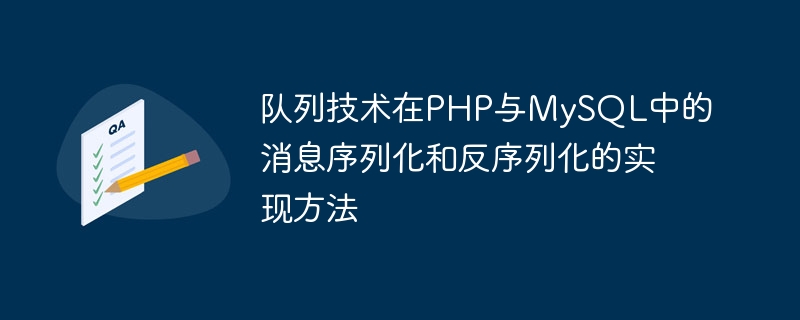Home >Backend Development >PHP Tutorial >How to implement message serialization and deserialization of queue technology in PHP and MySQL
How to implement message serialization and deserialization of queue technology in PHP and MySQL
- 王林Original
- 2023-10-15 10:46:071128browse

How to implement message serialization and deserialization of queue technology in PHP and MySQL
In web development, queue technology is widely used to process asynchronous tasks and message passing, which can improve the performance and scalability of the system. As a popular server-side programming language, PHP can be used in combination with the MySQL database to implement excellent web applications. This article will introduce the implementation method of message serialization and deserialization of queue technology in PHP and MySQL, and give specific code examples.
- Introduction to Queue Technology
Queue technology is a widely used data structure that follows the first-in-first-out (FIFO) principle and can realize the sequential execution of tasks. In web applications, queue technology is often used to handle some time-consuming tasks. After the tasks are added to the queue, the background process takes them out and executes them one by one. - Queue implementation method in PHP
In PHP, you can use a variety of methods to implement queues, such as using message queue services such as Redis and RabbitMQ. This article will use MySQL as the storage medium of the queue and use database tables to implement the queue.
(1) Create a queue table
First, create a table named queue to store messages in the queue. The table structure is as follows:
CREATE TABLE queue (
id INT AUTO_INCREMENT PRIMARY KEY, data TEXT, created_at DATETIME DEFAULT CURRENT_TIMESTAMP
);
The table contains three fields: id is the auto-incrementing primary key, data is the message content, and created_at is the message Creation time.
(2) Add a message to the queue
To add a message to the queue, you can use the following code example:
function enqueue($data) {
$tableName = 'queue';
$data = addslashes($data);
$query = "INSERT INTO $tableName (data) VALUES ('$data')";
// 执行SQL语句
// ...}
In the enqueue function, escape the message content $data and insert it into the queue table.
(3) Retrieve messages from the queue
To retrieve messages from the queue, you can use the following code example:
function dequeue() {
$tableName = 'queue'; $query = "SELECT * FROM $tableName ORDER BY created_at ASC LIMIT 1"; // 执行SQL语句并获取结果 // ... $data = $result['data']; return $data;
}
In the dequeue function, obtain the earliest created message through the SELECT query statement, and then delete it from the queue table.
- Message serialization and deserialization
In practical applications, messages are usually complex data structures that require serialization and deserialization operations. PHP provides a variety of serialization methods, such as using serialize and unserialize functions, JSON encoding and decoding, etc.
(1) Message serialization
Serialization is the process of converting data into a format that can be stored or transmitted. Taking the serialize function as an example, the following is a simple message serialization example:
function serializeMessage($message) {
return serialize($message);
}
In the serializeMessage function, use serialize Function serializes $message into a string.
(2) Message deserialization
Deserialization is the process of converting stored or transmitted data into original data. Taking the unserialize function as an example, the following is a simple message deserialization example:
function unserializeMessage($serializedMessage) {
return unserialize($serializedMessage);
}
In the unserializeMessage function, use The unserialize function deserializes $serializedMessage into raw data.
- Sample code
The following is a sample code that uses queue technology to process asynchronous tasks:
// Add messages to the queue
$message = array( 'task_id' => 1, 'content' => '...');
$serializedMessage = serializeMessage($message);
enqueue($serializedMessage);
// Get the message from the queue and process it
$serializedMessage = dequeue();
$message = unserializeMessage($serializedMessage);
$taskId = $message['task_id'];
$content = $ message['content'];
processTask($taskId, $content);
In the above example code, the task message is first serialized and added to the queue; then the message is taken out of the queue , perform deserialization and process the corresponding tasks. Finally, the corresponding processing function can be implemented according to the specific task content.
Summary:
This article introduces the implementation method of message serialization and deserialization of queue technology in PHP and MySQL, and gives specific code examples. By using queue technology, orderly processing of asynchronous tasks can be achieved, improving system performance and scalability. At the same time, PHP provides a wealth of serialization and deserialization functions, which can easily handle complex message data.
The above is the detailed content of How to implement message serialization and deserialization of queue technology in PHP and MySQL. For more information, please follow other related articles on the PHP Chinese website!

